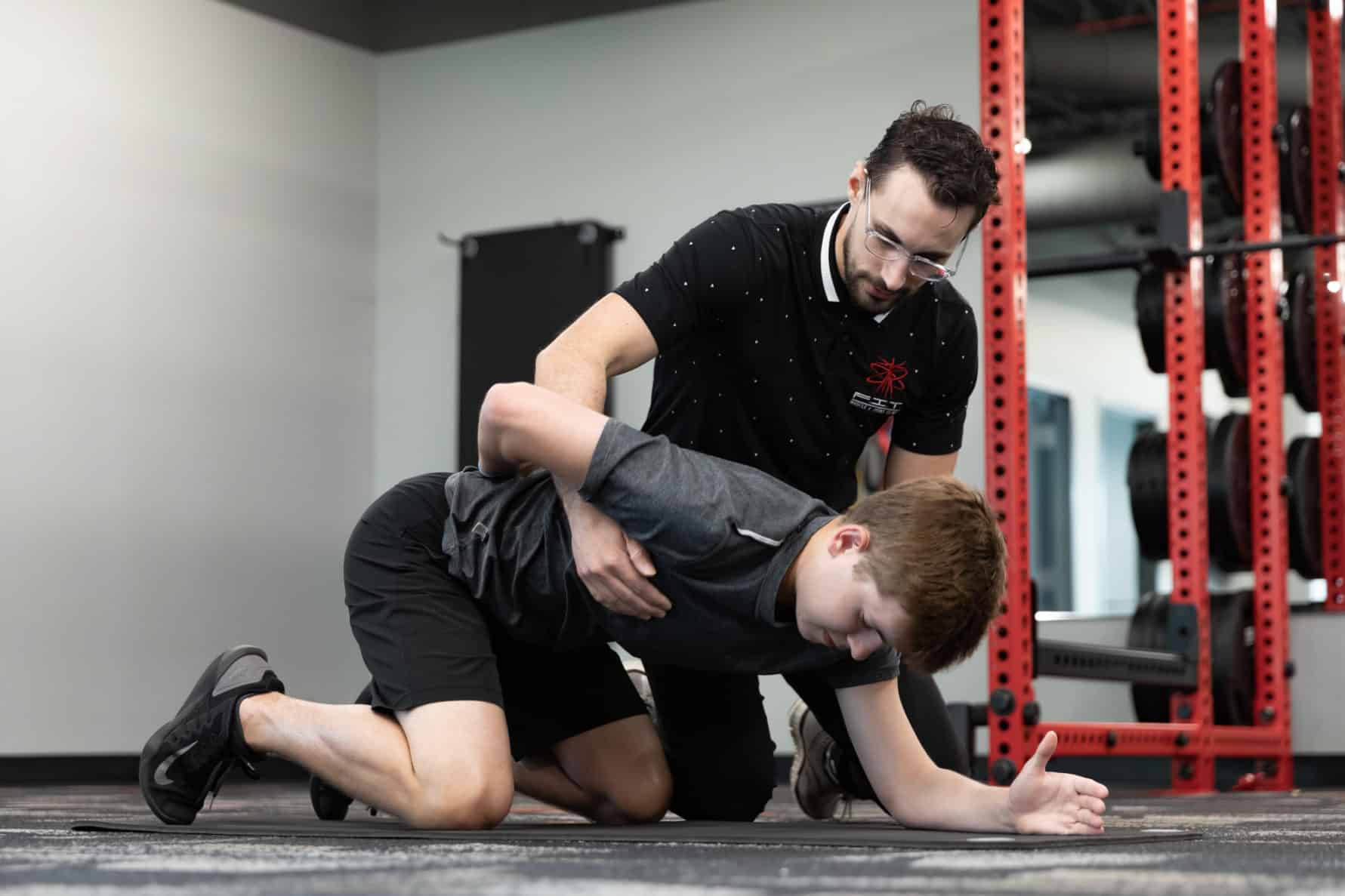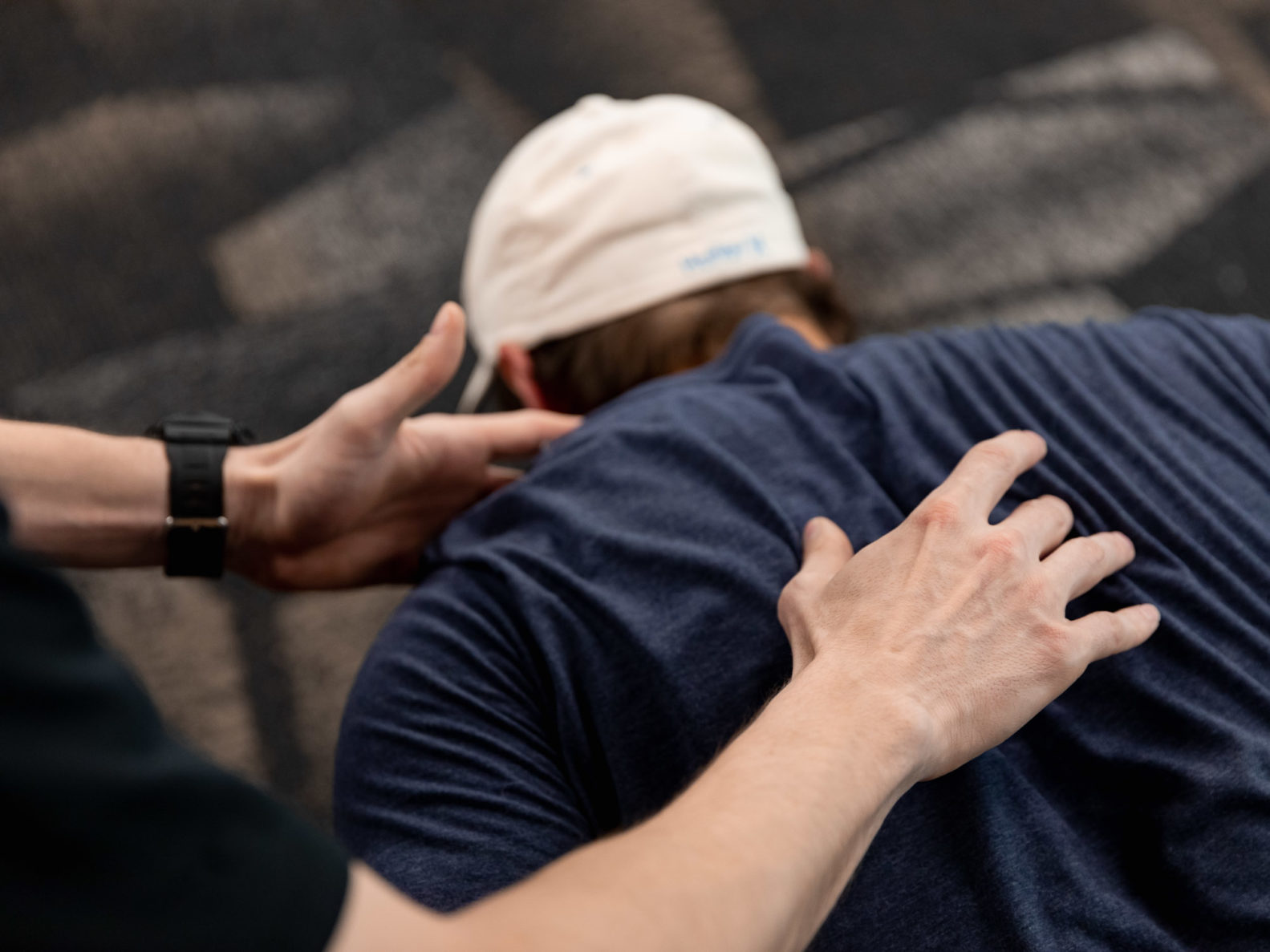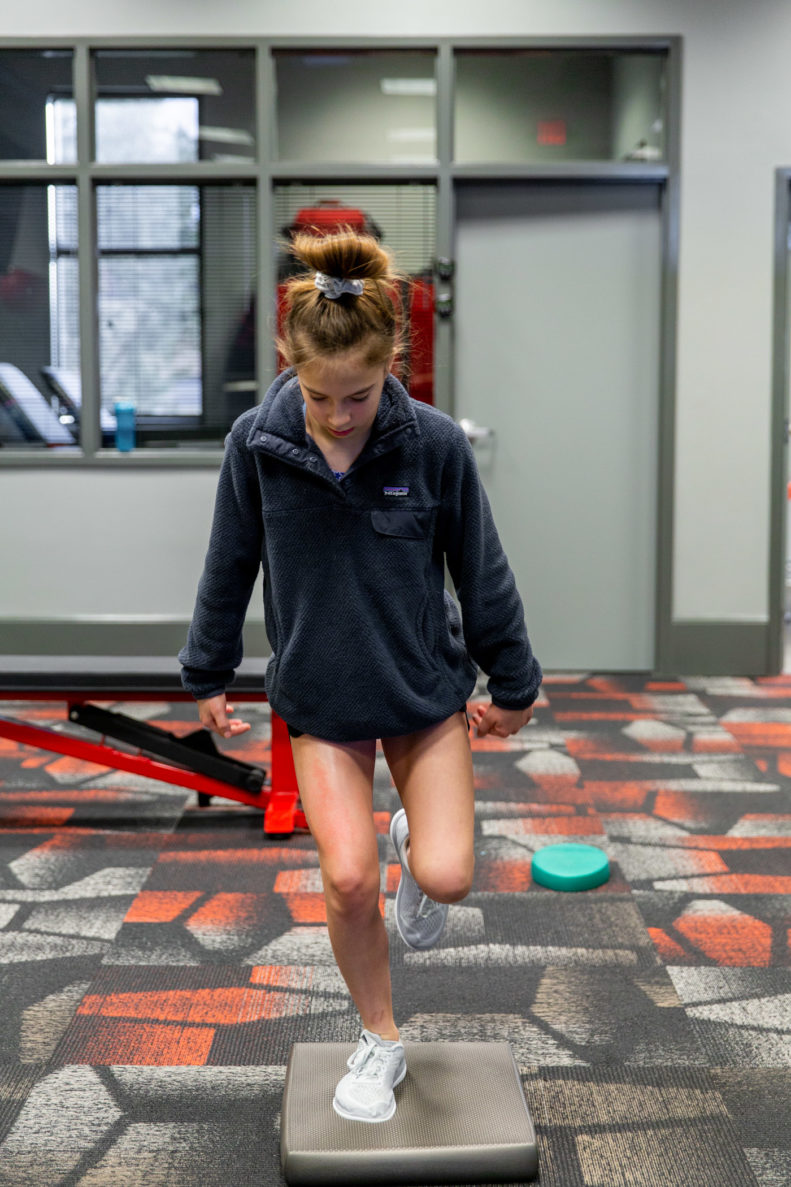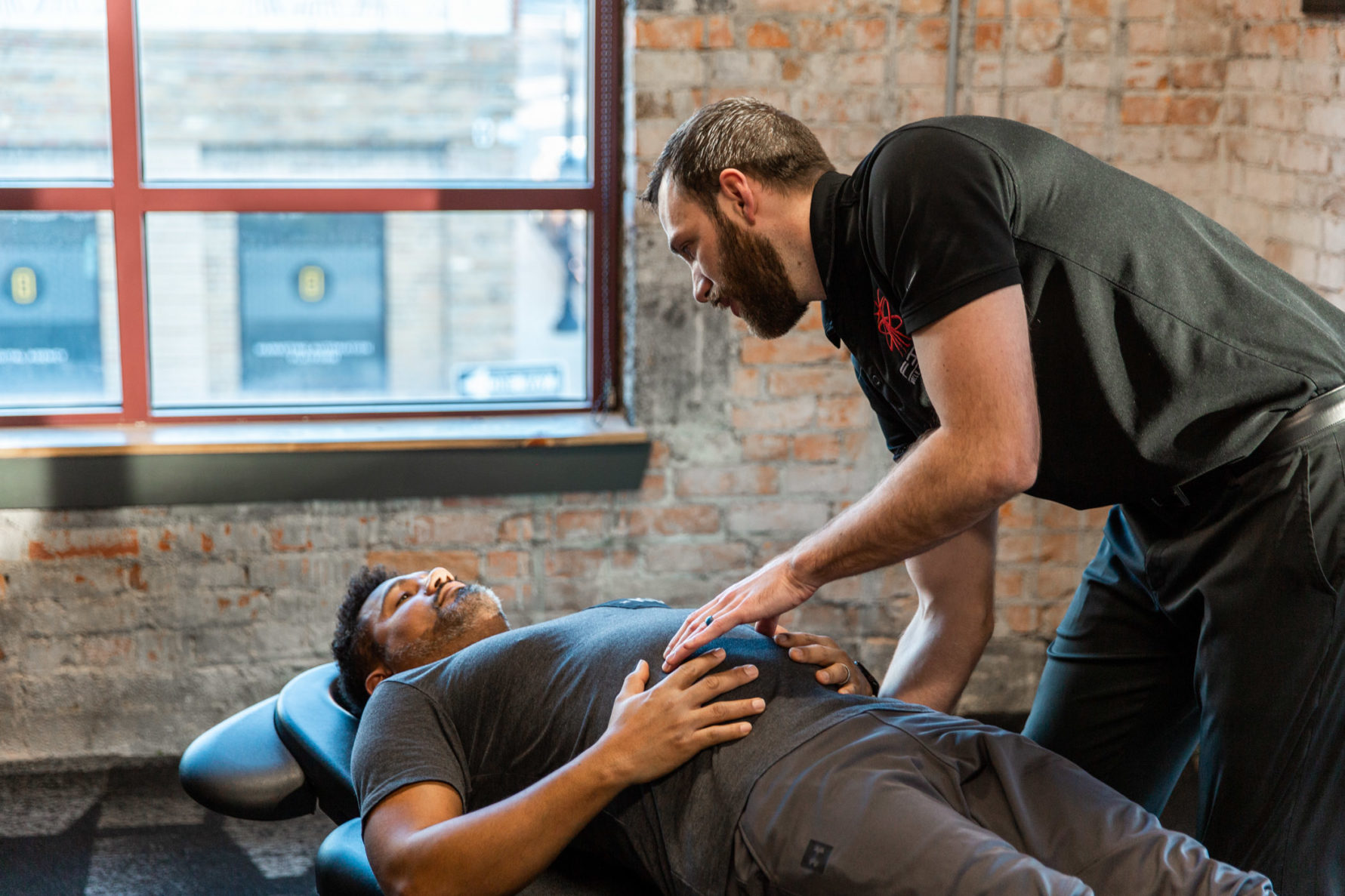
Our Chiropractic Rehabilitation favors quality of the exercise movement over quantity of reps as the key to restoring proper function.
Chiropractic Rehabilitation in Kansas City
Dynamic Neuromuscular Stabilization (DNS)
F.I.T. Muscle & Joint Clinic uses a combination of Dynamic Neuromuscular Stabilization (DNS) and functional movements as part of their rehabilitative exercise protocol. Our chiropractic rehabilitation in Kansas City focuses on proper exercise and movement patterns to allow patients to return to full function more efficiently and effectively.
DNS starts at the highest levels of our body’s functioning—the brain—to explain and correct proper movement quality. After studying how we develop as children, DNS has shown we are able to utilize normal developmental positions to retrain ideal movement in patients. By emphasizing quality over quantity in the office our patients are able to improve body awareness while decreasing pain and muscular compensations.
What It Treats
Chiropractic Rehabilitation Exercises in Kansas City can help with overall movement quality in activities of daily living. This is especially useful in musculoskeletal pain resulting from:
- Headaches and neck pain
- Low Back pain
- Hip Pain
- Plantar Fasciitis
- Achilles tendinitis
- Shoulder pain
- Carpal tunnel syndrome
- Sciatica and piriformis syndrome
- Knee pain
- IT band syndrome
- Little leaguer’s/tennis/golfer’s elbow

How Rehab Exercises Work
Rehab exercises, such as DNS, enable our doctors to use a detailed assessment to determine the primary area of dysfunction. This allows us to address any compensatory patterns that may be directly or indirectly causing the patient’s primary complaint of pain.
Through Dynamic Neuromuscular Stabilization (DNS), our chiropractic rehabilitation focuses on developmental kinesiology to ensure the joints and muscles maintain proper joint centration through their full range of motion. DNS puts the central nervous system (CNS) at the forefront of joint and muscular rehab. Simply put, motion stems from control centers in the brain that activate how the body functions and moves. The body establishes this motor control during the early stages of life (first few years). DNS aims to stabilize movement patterns by targeting the CNS, to remind the body how to use its inherent motor programming.
The key to injury rehabilitation and preventing future injuries isn’t simply strengthening or stretching out the muscles; it’s to reevaluate the body’s functional stability. Not meant solely for sitting and standing, stability is also crucial for moving the head and limbs. Stability isn’t something you have to think about; it happens naturally. That also means that poor stability becomes habitual and can stray away from healthy motor functions, leading to pain and injury.
Most mobility issues have an underlying stability issue. This can include tight muscles, stiff joints, or irregular muscle activation. Therefore, if even one area of the motion segment doesn’t move properly, it affects the entire stabilizing function of that movement. As a result, some muscles have to work harder when they aren’t meant to, causing extra strain or wear and tear.
Stabilization precedes movement. Whenever the body feels unstable, it restricts mobility. Many people will just stretch or foam roll when they feel tightness, when often it’s the body crying out for more stability, and less stretching. Knowing when to use soft tissue techniques, and when to use chiropractic rehabilitation exercises, is F.I.T.’s speciality.

Rehab Exercises at F.I.T.
F.I.T. Muscle & Joint Clinic uses some form of rehab exercise in each treatment session. The muscles and systems most in need of retraining are best determined through assessment and rehabilitative exercises such as DNS.
Rehabilitation exercises are a non-invasive therapy that focuses on improving motion patterns and promoting healing. Our team focuses on providing the best chiropractic rehabilitation in Kansas City to maximize patient outcomes. Because of this, we have trained and understand how to combine the best exercise techniques to individualize each treatment to a patient’s needs. This allows us to hone in on specific structures to target the underlying stabilization problems.
We first analyze and examine the body to evaluate not just where the pain lies, but also the source of the pain. From there, we decide which treatments and exercises would benefit a patient the most. Through a combination of DNS with other traditional rehabilitation exercises, we improve stability to reduce harmful muscle compensations and promote healthy motion patterns.
At F.I.T. Muscle & Joint Clinic, we strive to change the function of how your body utilizes certain muscles by incorporating more neurology (brain power) in these complex, yet somewhat simple, exercises. This is what allows our patients to move better and be stronger than before they found F.I.T.
Our chiropractors have helped countless patients with our chiropractic rehabilitation and have mastered the art of non-invasive musculoskeletal patient care. We don’t believe in generalized treatments simply because we don’t deal with generalized problems. At F.I.T. Muscle & Joint Clinic, we support our patients through their journey from start to finish.

How Rehab Exercises Target Muscle Compensations
With our in-depth examinations, our medically trained chiropractors gain insight on muscle compensations that could cause injuries down the road. This is important because when the body compensates a muscle weakness using a smaller muscle, it can lead to imbalances around the muscles and joints.
For example, large muscle movers—such as the glutes, hamstrings, and quads—may become inactive or weakened. As a result, the body turns to small stabilizer muscles to move, which goes against their primary function. When those stabilizers are overexerted, over time, this causes wear and tear. Without time to properly recover, broken down stabilizer muscles can limit training ability, and may become an injury in the making.
Fortunately, our chiropractic rehabilitation in Kansas City can retrain the way the body moves. By solving underlying stability issues and other weaknesses, rehabilitation exercises can reduce compensations and promote muscle strengthening. In doing so, our DNS-focused exercises help alleviate low back pain, headaches, hip pain, shoulder pain, IT band syndrome, carpal tunnel, and more.
We always recommend coming to one of our 11 offices across the Kansas City metro to determine if rehabilitation exercises are right for your body and your goals.

Developmental Kinesiology and Rehabilitation Exercises
Dynamic Neuromuscular Stabilization (DNS) is a popular concept in chiropractic rehabilitation and is based on the scientific principles of developmental kinesiology. Developmental kinesiology focuses on the idea that motor development in early childhood is pre-programmed and follows a common pattern. Parents don’t have to “teach” their children how to lift their head, reach for bottles, or crawl. These are all movement patterns that the central nervous system forms as it matures.
The idea is that during those early stages of development, muscles and joints work in harmony to create the right stabilization balance. As people age, different factors can disrupt the synergy, including:
- Abnormal postural development (such as from developmental delays)
- Incorrect form during learned activities
- Injuries leading to casts (such as a broken or fractured bone)
- Muscle weakness that affects joint stability
- Ligament insufficiencies
Some of these problems require surgery, while others may be treated with chiropractic rehabilitation in Kansas City. Our rehabilitation exercises at F.I.T. Muscle & Joint Clinic return the body back to the basics through DNS-focused movements that are inspired by early development motion patterns. Because of this, our exercises treat a variety of conditions and injuries such as back pain, tennis elbow, sciatica and piriformis syndrome, plantar fasciitis, and more.

Stabilization through intra-abdominal pressure (IAP)
For our rehabilitation exercises to successfully stabilize the body, we also focus on intra-abdominal pressure (IAP). IAP is the concept of pressurizing your core through diaphragmatic “belly” breathing.
To achieve IAP, patients breathe into their belly/core using the diaphragm rather than the accessory muscles of breathing in their chest, neck, and shoulders. Chest breathing uses muscles that aren’t meant for breathing, resulting in tight and imbalanced muscles throughout the chest, shoulders, mid-upper back, and neck. Diaphragmatic “belly” breathing is the most efficient way to breathe to maintain good spinal health and prevent issues with surrounding musculature.
At F.I.T. Muscle & Joint Clinic, IAP and central stabilization is the foundation of our chiropractic rehabilitation in Kansas City for almost all our patients. During rehabilitation exercises, it is especially important to practice IAP to maintain good core control, keep the back protected, and promote healing in injured areas.
Is Chiropractic Rehabilitative Exercise right for you?
Take a couple of minutes to tell us about your symptoms and pain areas. Prefer to chat over the phone? Call us for a free phone consultation.
Visit your local F.I.T.
Meet the team at any of our 11 locations: Lee’s Summit, Leawood, Liberty, Crossroads, Blue Valley, Kansas City, Paola, Olathe, Overland Park, Raymore & Shawnee.

